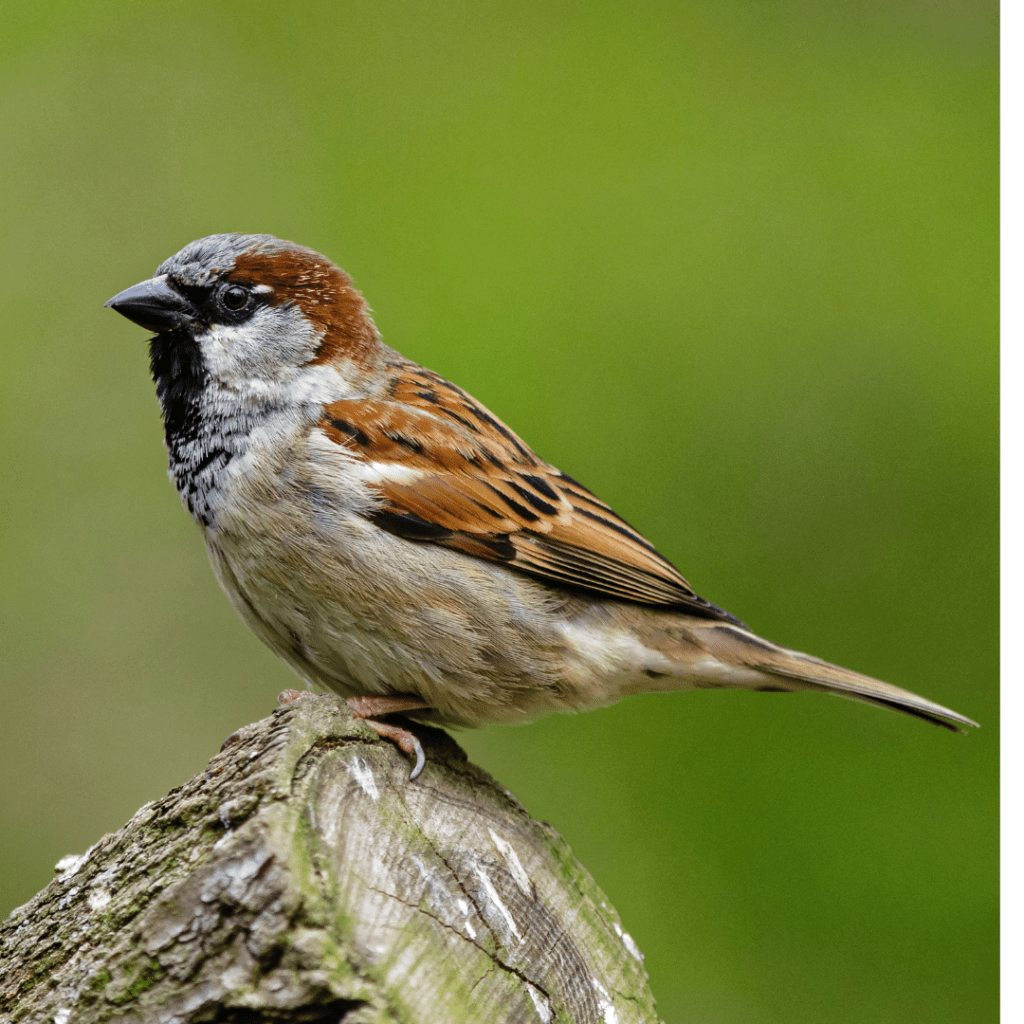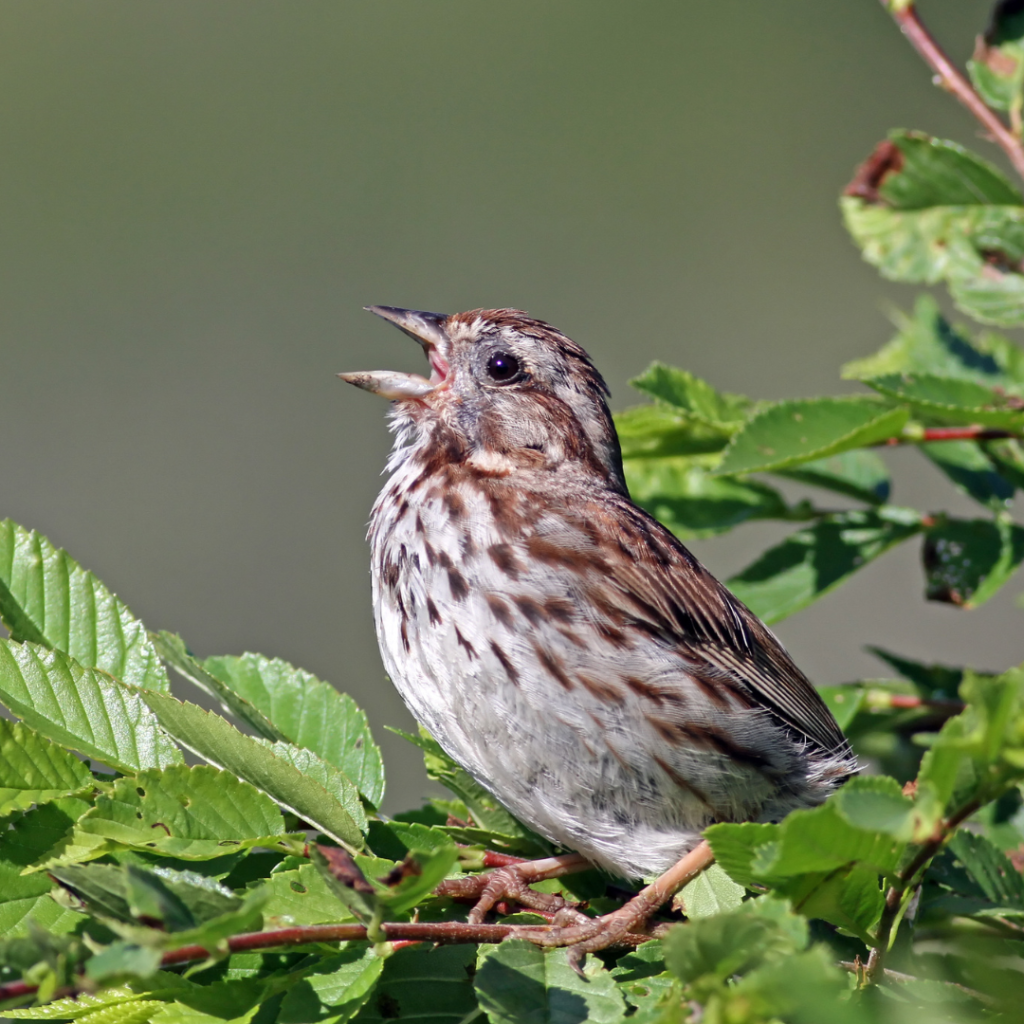To make it in the wild, you’ve gotta be tough, clever, and a little bit lucky.
For small birds like sparrows, life-threatening situations are part of daily life.
So, how long do sparrows live? While the estimated average lifespan of sparrows is around three years, many don’t survive their first year. A lucky few live to see 10 or more years.

Today, we’re discussing the longevity of sparrows, including how long they live, how they die, and how you can promote long lifespans for your local birds.
Here are the topics we’ll cover:
- How scientists estimate the lifespans of wild birds
- Average lifespans and longevity records for different sparrow species
- Common causes of death for sparrows
- Sparrow longevity compared to other birds
- How to help your local birds live long lives
Understanding the Lifespans of Wild Birds
Scientists face major challenges when attempting to estimate the longevity of wild animals.
To generate reliable average lifespan estimates, many individual birds of a species would need to be tracked from egg-hatching to death. However, significant effort is required to track even a single wild animal for the entirety of its life.
Simply observing or examining birds reveals little about their age. Once adulthood is reached, it’s very difficult to estimate the age of a bird using physical traits.
Further complicating the task is the reality that birds of the same species face different mortality challenges in different regions.
For example, pigeons in a highly-polluted city that’s home to a large number of feral cats may not live as long, on average, as pigeons in a cleaner city where predators are less abundant.
Finally, animals tend to live longer—sometimes much longer—in captivity.
Therefore, longevity estimates for wild animals don’t necessarily indicate the species’ biological potential for living long lives.
Rather, an average lifespan estimate is more of a guess at how long an animal can fend off various causes of natural and unnatural death, which vary from place to place and are constantly changing around the world.
How Scientists Research Wild Bird Longevity
Most of what we know about the longevity of wild birds comes from banding.
Bird banding consists of these three steps:
- Catching a wild bird
- Attaching a colored or aluminum band to the bird’s leg
- Releasing the bird

Bird banding is regulated by the federal governments of different nations. In the US, banding can only be performed by groups or individuals that receive permission from the Bird Banding Laboratory, (BBL) part of the United States Geological Survey (USGS).
To band small birds such as sparrows, banders use mist nets made from fine, nearly-invisible threads. Nets are stretched out between poles or inserted into tree canopies.
After a bird is caught, banders record key information, such as species, gender, size, and estimated age. The bird is then banded and released.
Each bird band applied in the United States contains a unique ID number that corresponds to an entry in the USGS database.
When a banded bird is caught or found again, the entry can be updated. In this manner, researchers are able to learn about the movements, health, and lifespans of birds.
What Is the Average Lifespan for a Sparrow?
Sparrows and other small songbirds are lucky to survive to adulthood. Birds that get that far can hope to live for a few more years.
So, how long do sparrows live, well the average lifespan for sparrows is typically 2-5 years.
However, it’s not easy to produce satisfactory “average” lifespan estimates for wild birds, especially when discussing groups as diverse and widespread as sparrows.
Most banded birds are never caught a second time, and thus their potential data points are lost.
Researchers that want to estimate the average lifespan for a species can use the mean or median from a bird banding data set. For songbirds, this usually results in estimates of around two or three years.
Since average lifespan estimates are so fuzzy, it’s useful to also consider longevity records, i.e. individual sparrows that have lived the longest documented lives.
Sparrow Longevity Records
The Bird Banding Laboratory does not provide average lifespan estimates for different bird species. However, the BBL does maintain a database of longevity records.
A longevity record is recorded when a banded bird is recaptured or found dead and the bird’s documented lifespan is the longest on record for its species.
A longevity record is only one data point, but in many cases, it’s the most useful statistic available for understanding the longevity of a species.
Longevity records, i.e. maximum lifespans, tend to be significantly longer than mean or median estimates. This indicates that birds are physically capable of living much longer lives in comparison to the typical lifespan that’s achieved in the wild.
Here are the longevity records for each species of sparrow that exists in the wild in the United States.
Sparrow Species | Longevity Record |
House sparrow | 15 years, 9 months |
White-throated sparrow | 14 years, 11 months |
Slate-colored junco | 11 years, 4 months |
Song sparrow | 11 years, 4 months |
Spotted towhee | 11 years, 0 months |
Chipping sparrow | 10 years, 11 months |
Field sparrow | 10 years, 11 months |
American tree sparrow | 10 years, 9 months |
Fox sparrow | 10 years, 4 months |
Eastern towhee | 9 years, 0 months |
Olive sparrow | 8 years, 3 months |
Swamp sparrow | 7 years, 10 months |
Rufous-crowned sparrow | 5 years, 1 month |
Eurasian tree sparrow | 4 years, 0 months |
Source: Department of the Interior United States Geological Survey
Longevity records are among the best available data points for understanding bird lifespans. However, they don’t tell the whole story.
More abundant species are more likely to be banded and re-captured, which is why common species such as house sparrows tend to present more impressive longevity records.
The worldwide longevity records for sparrows belong to house sparrows that lived in Europe. The oldest house sparrow in the wild lived past the age of 19, while the oldest house sparrow in captivity lived for 23 years.
What Are the Common Causes of Death for Sparrows?
Sparrows may be cheerful little birds, but the life of any wild animal is full of risk.
Commons causes of death for sparrows and other small songbirds include:
- Predation
- Disease
- Starvation
- Motor vehicles
- Collisions with windows and other glass surfaces
- Power line electrocution
Many sparrow species, such as house sparrows and song sparrows, are abundant in urban and suburban environments.
Living in close proximity to humans has benefits. Sparrows score easy calories from birdfeeders, litter, and landscaping plants. However, they’re also likely to die from human-related causes, such as catching diseases from food waste or being killed by outdoor domestic cats.
Predators That Hunt Sparrows
Sparrows are appealing prey for many predators. They’re tiny, not particularly tough, and they spend much of their time feeding on the ground, exposed and vulnerable.
Predators that hunt sparrows include:
- Domestic and feral cats
- Domestic and feral dogs
- Hawks, owls, and other birds of prey
- Coyotes, foxes, and bobcats
- Snakes
- Raccoons
Domestic and feral cats are, by far, the most dangerous predators for sparrows and other songbirds. It’s estimated that free-ranging cats, which are considered an invasive species, kill more than one billion birds per year.
How Do Sparrow Lifespans Compare to Other Birds?

The longevity of birds is highly variable and difficult to estimate. However, these two generalities apply:
- Birds can live much longer in captivity than in the wild
- Large bird species tend to live longer than smaller species
Sparrows are tiny, and they’re rarely held in captivity. So, sparrows and other smaller birds such as finches lifespans tend to be short.
The Bird Banding Laboratory longevity record database can be sorted by species according to the age of the record-holding bird. Doing so illuminates the lifespan difference between small and large birds.
Various species of albatross (a large family of seabirds) dominate the record book for the oldest documented wild birds.
Several banded Laysan albatrosses have survived past the age of 65. Other large birds, like cranes, eagles, and flamingos are also noted for longevity.
A Major Mitchell’s cockatoo named Cookie holds the record for the oldest bird. Cookie died in the Brookfield Zoo in Illinois in 2016 at the age of 82.
The oldest documented age ever reached by a bird in the wild is estimated at 70 (and counting) by Wisdom the albatross. It’s estimated that Wisdom has flown millions of miles in her lifetime, returning each year to raise her young on the Midway Atoll in the Hawaiian archipelago.
Remarkably, Wisdom is still laying and hatching eggs in her 70s.
Male Sparrow Chriping!
This is less related to the topic of the article, but I came across this and wanted to share it! Check out this beautiful sparrow chirping in the early morning sun.
Helping Local Birds Live Long Lives
If you’d like to help your neighborhood sparrows and other songbirds live long lives, maintain a wildlife-friendly property. Here are a few ways to contribute to the well-being of your local birds:
- Keep your cats indoors and report stray cats to your local animal shelter or animal control agency
- Bird-proof your windows with netting or stickers
- Maintain a bird feeder with healthy foods
- Maintain a bird bath full of clean water
- Grow a variety of trees, native plants, and pollinator-friendly plants
Many migratory songbirds return to the same area year after year. If you create a bird-friendly property, you can help generations of birds stay fed and healthy.

Kelly is an environmental science writer, naturalist, and birdwatcher. Kelly holds a master’s degree in environmental policy and has worked as an environmental analyst, urban planner, and professor of environmental planning.
